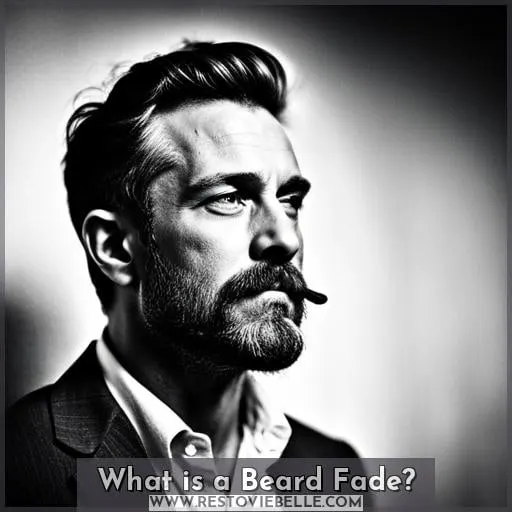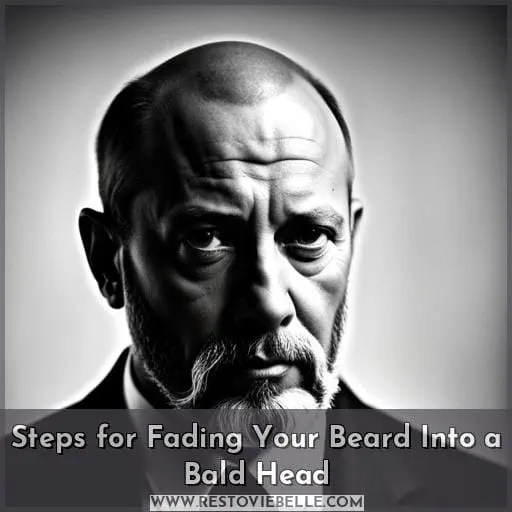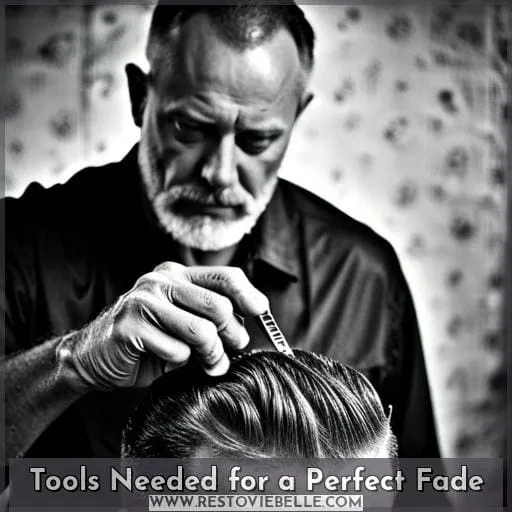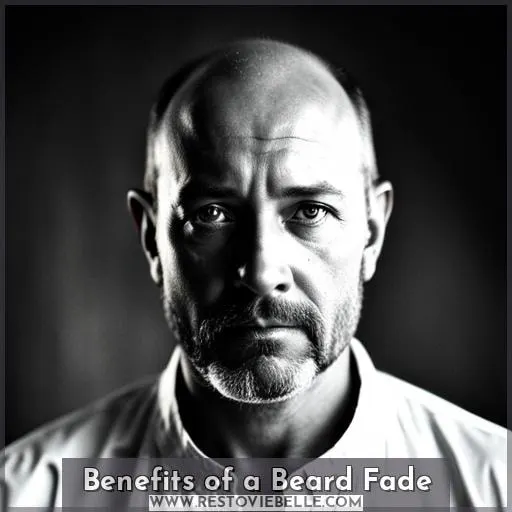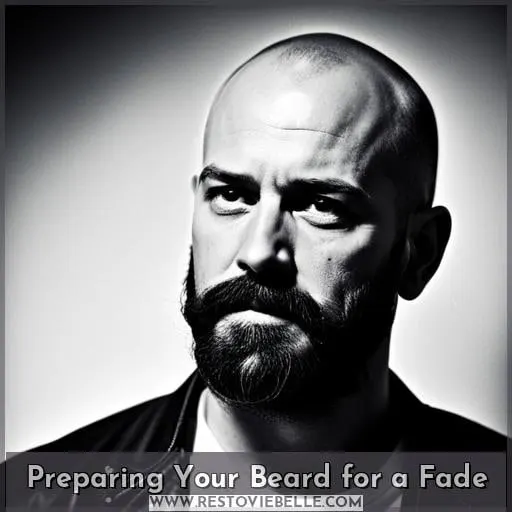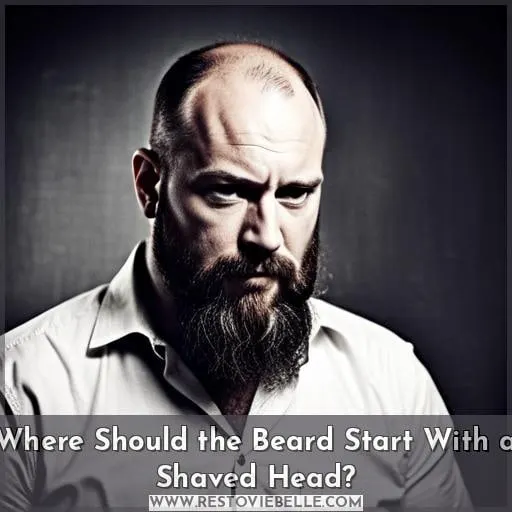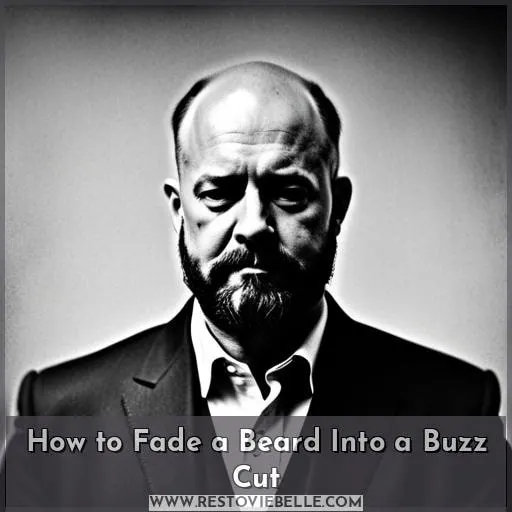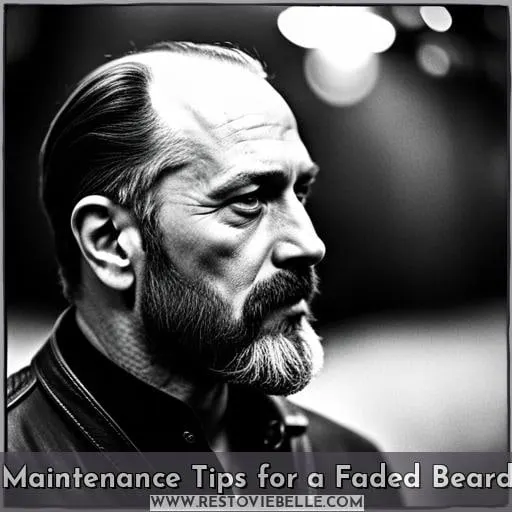This site is supported by our readers. We may earn a commission, at no cost to you, if you purchase through links.
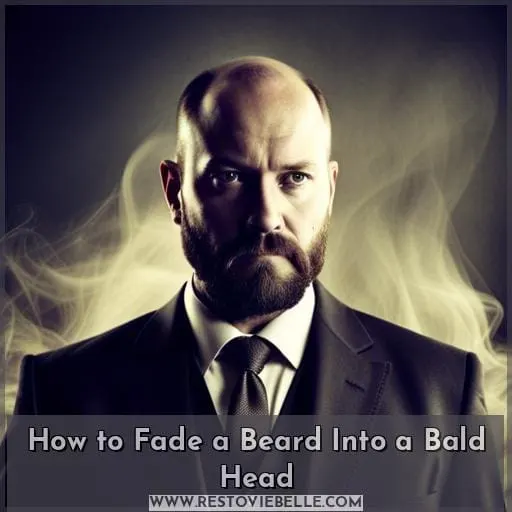 The art of fading a beard into a bald head can be as intricate and delicate as an artist’s brushstroke. Like any task that requires finesse, it takes the right tools, technique, and patience to get it just right.
The art of fading a beard into a bald head can be as intricate and delicate as an artist’s brushstroke. Like any task that requires finesse, it takes the right tools, technique, and patience to get it just right.
As with many fashion trends these days, this look has become increasingly popular among men of all ages who are looking for something unique yet stylish – especially those with receding hairlines or thinning hair on top.
Whether you’re new to the world of facial grooming or have been sporting your scruff for years now, learning how to fade a beard into a bald head is essential if you want that sharpest-looking transition between two distinct styles.
Table Of Contents
Key Takeaways
- Fading a beard into a bald head is a stylish grooming technique.
- Quality trimmers with adjustable settings are crucial for achieving a seamless transition.
- Proper grooming products like waxes, balms, and oils are essential for maintaining a faded beard.
- Celebrity-inspired looks often incorporate faded sideburns.
What is a Beard Fade?
You can achieve a fashionable look by seamlessly blending your beard with a bald head, and understanding the importance of maintaining your facial hair is key to achieving this stylish transition. A beard fade is an important part of grooming, which involves transitioning from long to short hair or into a completely bald head.
It’s also essential for creating sharp lines and contours in various styles. These styles include hipster, line up beards, undercut fades, slicked back undercuts, and more. To properly maintain your beard fading techniques, it’s important to use quality products like trimmers with adjustable settings.
This way, you can create precise transitions between lengths without making mistakes when trimming or cutting too much off at once.
Additionally, there are celebrity-inspired bearded looks that incorporate faded sideburns. These looks offer more natural-looking results when connected correctly down the neckline towards the jawbone area.
To finish off any style, it’s just as crucial not to forget about proper styling product usage.
Steps for Fading Your Beard Into a Bald Head
Before you begin fading your beard into a bald head, it is important to properly prepare and trim your facial hair. Start by untangling any knots or mats in the beard with a comb or brush before moving on to trimming.
Be sure to take care when trimming that you are going in the right direction – from bottom up – for proper shaping and styling of the fade.
Untangling Your Beard
Brushing through your coarse facial hair before trimming is a must, so give it some TLC and take the time to detangle those hairs like you would with any other mane. Use beard products that are specifically tailored for your skin type and hair texture.
Styling tips include using wide-toothed combs or boar bristle brushes to help smooth out knots while avoiding breakage. Take extra care when detangling near the neckline and sideburns as these areas will be important for transitioning into a bald scalp during the fading process.
For best results, use quality grooming tools such as trimmers with adjustable lengths or electric clippers instead of scissors.
Trimming Your Beard
Once you’ve prepped your beard, it’s time to start trimming! Get the right tools: a trimmer with adjustable length settings and quality beard care products. Set up your neckline, cheek line, or sideburns for fading. Begin at designated points, gradually adjusting the clipper number until the desired look is achieved.
Remember to go in the direction of hair growth when shaping and use shorter lengths for a natural transition from a bald head to a full-bodied beard.
Trimming in the Right Direction
Trim carefully, directing the clippers downwards from your cheeks to your neckline for a smooth transition.
Create sharp lines around the cheekbones for a defined look, then adjust gradually as you go down towards the neckline with shorter lengths until naturally fading into bald skin. Consider different styles such as line up fades or low taper fades that will result in attractive looks while still maintaining neatness and control over beard growth.
For extra maintenance tips, use special combs designed specifically for facial hair grooming.
Fading the Sideburns
Fade your sideburns down seamlessly for a natural, stylish connection to your bald head.
- Identify the fade points.
- Choose the right clipper number and trimmer setting.
- Trim carefully starting from designated points.
- Adjust length settings for a gradual transition.
To achieve this look, use beard grooming tools such as scissors, a comb, and trimmers with adjustable guards so you can customize the degree of fading. Focus on key areas like the neckline, cheek line, and sideburns for an attractive appearance that flows naturally into baldness at the top or sides of the head.
With proper care techniques in place, like shaving against the grain direction when trimming sideburns or using a hot towel to soften before styling, you’ll have an amazing blended look!
Tools Needed for a Perfect Fade
To achieve the perfect fade, you’ll need to have the right tools at your disposal. A good quality hair clipper will provide the most precise cut and a closer shave for longer-lasting results. Trimmer attachments can also help control length and shape when fading from a bald head into beard growth.
Additionally, having an array of beard products such as waxes, balms, and oils is essential for proper maintenance of facial hair health while achieving desired styling effects with ease.
Lastly, use combs or brushes specifically designed for beards to ensure that each strand lies in place before trimming begins.
With all these items at hand, you’re ready to create any look: from short stubble goatees to full chinstrap styles; sideburns connected seamlessly with a bald head; low skin fades on long beards; undercuts paired with slicked back designs – whatever your preferred style might be!
Benefits of a Beard Fade
For those looking to embrace the combination of a bald head with a beard for fashionable appeal, opting for a beard fade can be an ideal solution. A carefully crafted faded transition between both hairstyles will enhance facial features and create a seamless look, making it easier to achieve the stylish and trendy appearance desired.
Enhanced facial features.
By enhancing your facial features with a stylish beard fade, you can effectively give yourself a bold new look that will set you apart and turn heads. Facial hair grooming techniques, such as beard shaping and styling options, provide an opportunity to customize the contrast between a bald head and facial hair for sophisticated results.
Investing in quality beard products is essential for achieving desired outcomes when it comes to maintaining, fashioning, or styling your facial hair.
Seamless bald-to-beard transition.
Achieving a seamless transition between your bald head and beard can help you look sharp and stylish. To ensure the best results, practice proper beard care and use quality products like grooming oils or balms to condition hair follicles.
Trimming techniques are also key when fading a beard into a bald head. Aim for natural lines that don’t extend past your cheeks or neckline.
Lastly, experimenting with different styles will give you an idea of what works best for you. Try low fades with undercuts, lineups with goatees, or mutton chops in combination with texture on top.
Stylish and trendy look
You can achieve an incredibly stylish and trendy look by combining a bald head with your facial hair. Achieving this requires proper beard grooming, styling tips, and knowledge of the latest facial hair trends.
Bald head care is essential to ensure a seamless transition from your beard into your scalp. Start by choosing the right products for length maintenance or shaping up any stray hairs along the neckline or cheek line.
Take advantage of Barbering tools such as trimmers and clippers to accurately define each area for maximum impact without neglecting detail in order to get that perfect fade every time!
Preparing Your Beard for a Fade
Before attempting to fade your beard into a bald head, prepare it with products and untangle any knots for an even trim. Grooming products such as beard oil, balm, or wax can help make facial hair softer and easier to style.
Additionally, consider using a buzz cut clipper attachment if you want the most precise results.
When it comes to styling options for fading beards into bald heads, there is no one-size-fits-all approach. Everyone’s face shape will require different techniques that work best for them. It’s important to remember that this process requires patience. It takes time to get accustomed to proper cutting angles and understand which areas should remain longer than others while still creating an attractive look from all sides of the head/face combination transition line up.
For effective fades, start by identifying fade points and using the right clipper number. Make sure to attach the trimmer setting correctly and adjust length settings naturally. Then, trim carefully starting at designated points such as the neckline, cheek line, and sideburns.
Furthermore, when prepping your beard, ensure you have consideration towards its care routine. Using quality grooming items like oils and balms optimizes results while keeping the skin hydrated beneath facial hair growth.
This also prevents breakage around the edges where thinning may occur due to harsh cuts during blending processes.
Where Should the Beard Start With a Shaved Head?
To create a seamless transition between your facial hair and bald head, it’s important to consider where the beard should start. Your face shape is key in determining the optimal length of your beard as well as its placement on your neckline.
A round-shaped face can benefit from a slightly longer style that extends below the chin, while an angular or square-shaped face will need shorter stubble for balance. Opting for a classic goatee with a mustache is one way to achieve this look without overdoing it.
The right amount of maintenance plays an important role in achieving this style too. Keep up with regular trims around twice per month, depending on how quickly your beard grows.
Taking all of these factors into consideration will ensure that you have achieved the perfect fade between your facial hair and shaved head, giving you confidence no matter where you are going!
How to Fade a Beard Into a Buzz Cut
Achieving an attractive look requires carefully blending a buzz cut with your facial hair for a seamless transition. To get the desired style, you’ll need to trim and groom your beard in conjunction with the short-clipped sides of the fade.
- Identify where you’d like the fade line on each side to be and mark them off using clippers or trimmers as guide points.
- Select a clipper guard size that is appropriate for both fading from long hairs into shorter ones and maintaining stubble.
- Start trimming by gradually adjusting length settings at designated points until you achieve natural, blended transitions between longer lengths of hair close to your face down into closely clipped areas near the neckline or cheekbones – taking care not to overdo one area more than another!
With these tips in mind, choose from various buzz cut styles such as low taper fades paired with full beards or sleek undercuts topped off by cool designs that showcase bald head beard care at its finest!
Maintenance Tips for a Faded Beard
Maintaining your faded beard requires consistency, as studies show that trimming a few millimeters every two weeks can increase its longevity by up to 25%.
- Cleanse and condition the facial hair daily with specialized products to keep it healthy and hydrated.
- Regularly use a quality trimmer or clipper on low settings while following the contours of your face shape for an even look.
- Shape sideburns, cheek line, neckline, and mustache area using scissors after wetting them down first to avoid mistakes during the grooming session.
Conclusion
Creating the perfect beard fade for a bald head is a delicate art. It requires precision and finesse, much like a sculptor chiseling away excess stone to reveal a masterpiece. To achieve a seamless transition from bald to beard, you need the right tools, preparation, and technique.
A faded beard can enhance your facial features and give you a stylish, trendy look. Whether you want to blend stubble with a bald head, fade a full beard into a buzz cut, or shape up your sideburns, a faded beard can be the perfect companion to a bald head.
So, if you’re ready to show off your bald head with a stylish beard, let’s get to work and take your look to the next level!
